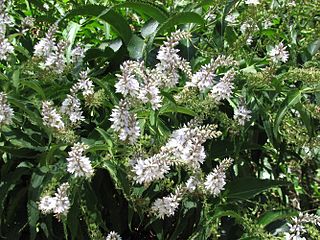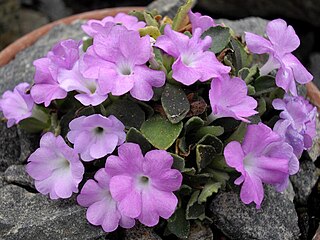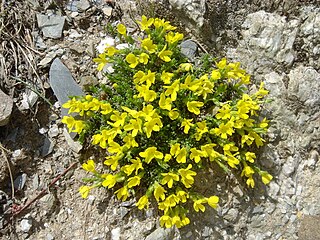
Primula bulleyana is a species of flowering plant in the family Primulaceae, native to hillsides in China.

Primula vulgaris, the common primrose, is a species of flowering plant in the family Primulaceae, native to western and southern Europe, northwest Africa, and parts of southwest Asia. The common name is primrose, or occasionally common primrose or English primrose to distinguish it from other Primula species also called primroses. None of these are closely related to the evening primroses.

Primula florindae, the Tibetan cowslip or giant cowslip, is a species of flowering plant in the family Primulaceae, native to southeastern Tibet, where it grows in huge numbers close to rivers such as the Tsangpo. It is a substantial herbaceous perennial growing to 120 cm (47 in) tall by 90 cm (35 in) wide. In summer the flower stalks rise from basal rosettes of 5–20 cm (2–8 in) long leaves. They bear clusters of 20–40 yellow, pendent, bell-like, delicately scented flowers with a mealy white bloom.

Primula elatior, the oxlip, is a species of flowering plant in the family Primulaceae, native to nutrient-poor and calcium-rich damp woods and meadows throughout Europe, with northern borders in Denmark and southern parts of Sweden, eastwards to the Altai Mountains and on the Kola Peninsula in Russia, and westwards in the British Isles.

Primula scotica, commonly known as Scottish primrose, is a species of flowering plant in the family, Primulaceae, the primroses and their relatives. It was discovered by James Smith, and is endemic to the north coast of Scotland.

Blandfordia, commonly known as Christmas bells, is a genus of four species of flowering plants native to eastern Australia. Christmas bells are tufted, perennial herbs with narrow, linear leaves and up to twenty large, drooping, cylindrical or bell-shaped flowers.

Primula matthioli, synonym Cortusa matthioli, sometimes called alpine bells, is a flowering plant with a wide distribution in the Palearctic, both in Europe and in temperate Asia, from Siberia in the north to Afghanistan, Pakistan and China in the south.

Kennedia is a genus of thirteen species of flowering plants in the in the pea family Fabaceae and is endemic to Australia. Plants in this genus are prostrate or climbing perennials with trifoliate leaves and large, showy, pea-like flowers. There are species in all Australian states.

Primula denticulata, the drumstick primula, is a species of flowering plant in the family Primulaceae, native to moist alpine regions of China, Afghanistan, Bhutan, India, Kashmir, N Myanmar, Nepal, and Pakistan. It is an herbaceous perennial growing to 45 cm (18 in) tall and wide, with rosettes of oval leaves and sturdy stems bearing spherical umbels of purple flowers in late spring and early summer. Flowers can also be lavender, pink, or white in colour.

Olearia phlogopappa commonly known as the dusty daisy-bush or alpine daisy-bush is a species of flowering plant in the family Asteraceae that is commonly found in eastern New South Wales, Victoria and Tasmania. It is a small shrub with greyish-green foliage, daisy-like flowers in white, pink or mauve that can be seen from spring to late summer.

Veronica derwentiana, commonly known as Derwent speedwell, is a flowering plant species of the family Plantaginaceae, endemic to south-eastern Australia. It is a perennial with toothed leaves and white or pale blue flowers in terminal sprays in spring and summer.

Cyclamen rhodium is a species of flowering plant in genus Cyclamen of the family Primulaceae, native to the Peloponnese, Rhodes, and southwestern Kos. It is a tuberous perennial growing to 10 cm (4 in), with mottled, heart-shaped leaves and pink flowers, darker carmine pink at the base, appearing in spring. Like all cyclamens, the flowers consist of five upswept, reflexed petals.

Colchicum bulbocodium, the spring meadow saffron, is a species of alpine bulbous plant native to mountain ranges across Europe from the Pyrenees to the Caucasus.

Primula allionii is a species of flowering plant in the family Primulaceae, native to southern France and northern Italy where it is found on cliffs at an altitude of 700–1,900 metres (2,300–6,200 ft). It is a small, spreading, evergreen perennial growing to 10 centimetres (3.9 in) tall by 20 centimetres (7.9 in) wide, with leathery, hairy leaves and pink flowers in late winter and early spring.

Primula frondosa, the leafy primrose, is a species of flowering plant in the family Primulaceae, native to the Balkans. It inhabits shady spots in a small region of the central Balkan Mountains range in Bulgaria, where it is found at altitudes from 800 to 2,200 m. Its populations are situated within the boundaries of the Central Balkan National Park and the nature reserves Sokolna, Dzhendema and Stara Reka.

Eucalyptus pauciflora subsp. niphophila, commonly known as snow gum, is a small tree or large shrub that is native to a few mountain peaks in eastern Australia. It has smooth bark, glossy green, lance-shaped to egg-shaped or elliptical leaves, flower buds in groups of between nine and fifteen, white flowers and cup-shaped, hemispherical or conical fruit. It differs from other subspecies of E. pauciflora in having more delicate, pedicellate flower buds and smaller leaves.

Androsace vitaliana is a species of plant in the primrose family, Primulaceae. It was previously known by the synonym Vitaliana primuliflora. Native to the high mountains of Europe, it is cultivated as an alpine garden plant, being considered easy to grow in well drained soil in a sunny position.

Primula amethystina is a species of flowering plant in the family Primulaceae, native to China. The plant is commonly found in west and northwest Yunnan and southwest Sichuan, and across the border in Tibet. It typically grows best in wet, boggy soil.

Primula capitata, commonly known as the round-headed Himalayan primrose or Asiatic primrose is a species of flowering plant in the family Primulaceae. It is a short-lived perennial, forming semi-evergreen rosettes of 15cm pale green, mealy leaves that are finely toothed, oblong-lance-shaped or inversely lance-shaped, with white-mealy undersides. Its flowers are up to 1cm long, dark purple and tubular, with shallowly lobed petals; they are borne in racemes that form flattened spheres, held on white-mealy stems about 40cm high.
Primula aureata is a species of flowering plant from the family Primulaceae.



















